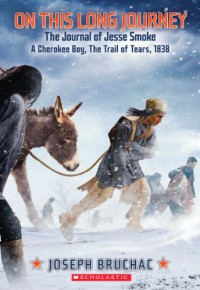

In 1838 in Tennessee, the Cherokee Nation is on the brink of being changed forever as they face the Removal -- being forcibly moved from their homes and land, in part because of a treaty signed by a group of their own people. Sixteen-year-old Jesse Smoke has been studying at the Mission School, but it has been shut down and turned into a fort for the ever-increasing number of soldiers entering the territory. Now Jesse has returned to his home to live with his widowed mother and two younger sisters. All hope lies on the Cherokee chief, John Ross, who is in Washington, D.C., trying to delay the Removal. Then one night, family members are suddenly awakened, dragged from their homes, and brought at gunpoint to a stockade camp. From there, Jesse and his family are forced to march westward on the horrifying Trail of Tears during the long, cold winter months. It's a difficult journey west, and Jesse's not sure if he and his family can survive the journey.
Amazon.com
Another selection from Scholastic's historical fiction epistolary novels for middle-grade readers, this time from Joseph Bruchac. I'd not heard of his books before, but it turns out Bruchac has a number of Native American themed novels under his belt!
Our protagonist this time is 16 year old Jesse Smoke, a Cherokee boy who unfortunately comes to experience The Trail of Tears. When we first meet Jesse, he only hears stories of other small communities outside of his own being moved across the country. The movement all begins when a group of Cherokee chiefs sign a treaty that, unbeknownst to them, completely signs over all Cherokee land to the U.S. government. In exchange, starting in the fall of 1838 the Cherokee people, along with members of the Muscogee, Seminole, Chicasaw, & Choctaw nations as well as black slaves and white family members of the Native American people are made to walk what came to be known as the Trail of Tears until they reach government allotted land for them (in this story they are being relocated to Mississippi from Tennessee). Chief John Ross goes to Washington, D.C. to try to reverse the treaty or at least try to get postponements for the remaining scheduled relocations. His efforts are for naught. Jesse and his family -- in fact, his entire community -- find their time come around the following May. Jesse's experience throughout the following months is shared via his journal entries, which carry through to February of 1839.
Soon after leaving Calhoun, Tennessee, trouble began. People became sick from drinking stagnant water and eating sour grapes by the roadside. So many were ill that the caravan halted more than a week. People began to die, especially children and the old. Among the many buried by the roadside was Chief Dreadful Waters, one of the signers of the Treaty of 1817, which promised us our lands forever.
As I said with Kathryn Lasky's Blazing West, this diary-style format of teaching the historical period is bound to appeal to middle-grade and YA students / readers in general. There is a bit more reference to violence in this one though. Jesse tells of his father being murdered by a white man and a woman who was an eyewitness bystander to the incident later being found dead with her throat cut. Jesse also shares stories of having to witness family and friends die of illness or exposure to the elements as well as his own experience of trying to speak with a soldier, getting the butt of a rifle to the face in response, leaving him in serious pain for months after.

This novel will help young readers gain a rudimentary understanding of the time period, not only through Jesse's fictional story but also through the supplemental material included at the end of the book, which offers a brief synopsis of the actual history, including photographs, maps and other images to further explain the story. I personally struggled with what felt, to me, like a lack of an authentic voice. The tone or the way Jesse spoke either sounded too old to feel believable for a teenage boy, or it was simplified to the point of making him sound much younger. All in all, a good starting place to get young readers interested in learning more, but definitely have supplemental references.

 2
2








